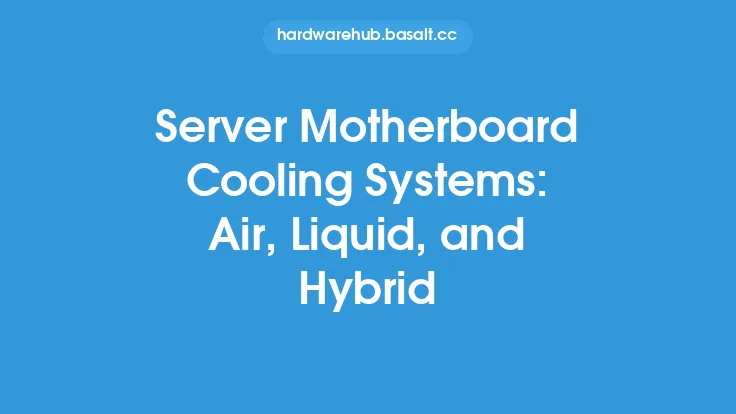When it comes to liquid cooling systems, there are several key components that work together to provide effective cooling for your computer. These components include pumps, radiators, and blocks, each of which plays a crucial role in the overall functioning of the system. In this article, we will delve into the details of each of these components, exploring their design, functionality, and importance in the liquid cooling process.
Pumps
The pump is the heart of any liquid cooling system, responsible for circulating the coolant through the system. There are several types of pumps available, including centrifugal, rotary, and diaphragm pumps. Centrifugal pumps are the most common type used in liquid cooling systems, as they are reliable, efficient, and relatively inexpensive. These pumps use a spinning impeller to create a pressure differential, drawing coolant into the pump and pushing it out to the rest of the system. Rotary pumps, on the other hand, use a rotating shaft to create a pressure differential, and are often used in high-performance systems where high flow rates are required. Diaphragm pumps, which use a flexible diaphragm to create a pressure differential, are less common in liquid cooling systems, but are often used in applications where low flow rates are sufficient.
When selecting a pump for your liquid cooling system, there are several factors to consider. The first is the flow rate, which is measured in liters per minute (L/min) or gallons per minute (G/min). A higher flow rate is generally desirable, as it allows for more efficient cooling. However, it's also important to consider the pressure head of the pump, which is the maximum pressure that the pump can generate. A higher pressure head is required for systems with longer tubing runs or more restrictive components. Additionally, the power consumption of the pump should be considered, as well as the noise level and durability.
Radiators
The radiator is another critical component of a liquid cooling system, responsible for dissipating heat from the coolant to the surrounding air. Radiators are typically made of a thin, flat material, such as aluminum or copper, and are designed to maximize surface area. There are several types of radiators available, including tube-and-fin, plate-and-frame, and mesh radiators. Tube-and-fin radiators are the most common type, and consist of a series of tubes that are bonded to a finned surface. Plate-and-frame radiators, on the other hand, consist of a series of plates that are stacked together, with a frame holding them in place. Mesh radiators, which consist of a mesh of thin wires, are less common, but are often used in applications where high airflow is required.
When selecting a radiator for your liquid cooling system, there are several factors to consider. The first is the size, which is typically measured in millimeters (mm) or inches (in). A larger radiator is generally more effective at dissipating heat, but may be more difficult to install. The material of the radiator is also important, as some materials (such as copper) are more effective at conducting heat than others (such as aluminum). Additionally, the fin density and tube size should be considered, as these can affect the performance of the radiator. Finally, the radiator's compatibility with your system's fans and other components should be taken into account.
Blocks
The block, also known as the waterblock, is the component that comes into direct contact with the heat source (such as the CPU or GPU) and transfers heat to the coolant. There are several types of blocks available, including full-cover blocks, universal blocks, and custom blocks. Full-cover blocks are designed to cover the entire surface of the heat source, and are typically used for CPUs and GPUs. Universal blocks, on the other hand, are designed to be compatible with a wide range of heat sources, and are often used for other components such as chipsets and RAM. Custom blocks, which are designed specifically for a particular heat source, are less common, but can offer improved performance.
When selecting a block for your liquid cooling system, there are several factors to consider. The first is the material, which is typically copper, aluminum, or a combination of both. Copper is generally more effective at conducting heat, but can be more expensive. The design of the block is also important, as some designs (such as those with a micro-fin structure) can be more effective at transferring heat to the coolant. Additionally, the block's compatibility with your system's heat source and other components should be taken into account. Finally, the block's flow rate and pressure drop should be considered, as these can affect the overall performance of the system.
Compatibility and Integration
When selecting components for your liquid cooling system, it's also important to consider compatibility and integration. The components should be compatible with each other, as well as with your system's other components (such as the case, motherboard, and power supply). The tubing and fittings should be compatible with the components, and the system should be designed to minimize restrictions and pressure drops. Additionally, the system's fans and other components should be integrated into the overall design, to ensure optimal airflow and cooling performance.
Conclusion
In conclusion, the components of a liquid cooling system (including pumps, radiators, and blocks) are critical to its overall performance and effectiveness. By understanding the design, functionality, and importance of each component, you can select the right components for your system and ensure optimal cooling performance. Whether you're building a high-performance gaming system or a quiet, efficient workstation, a well-designed liquid cooling system can provide reliable and effective cooling for years to come. By considering the factors outlined in this article, you can create a liquid cooling system that meets your needs and provides optimal performance.





